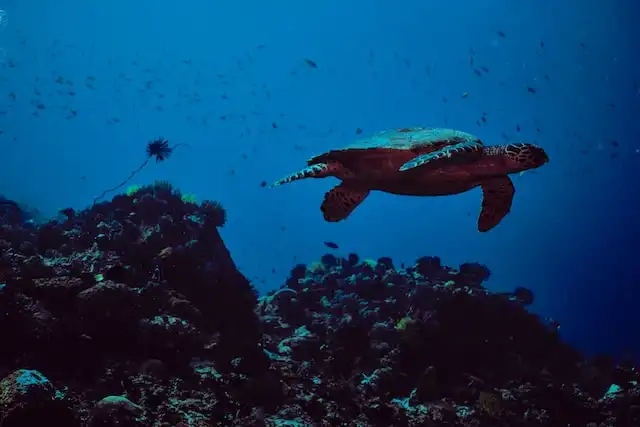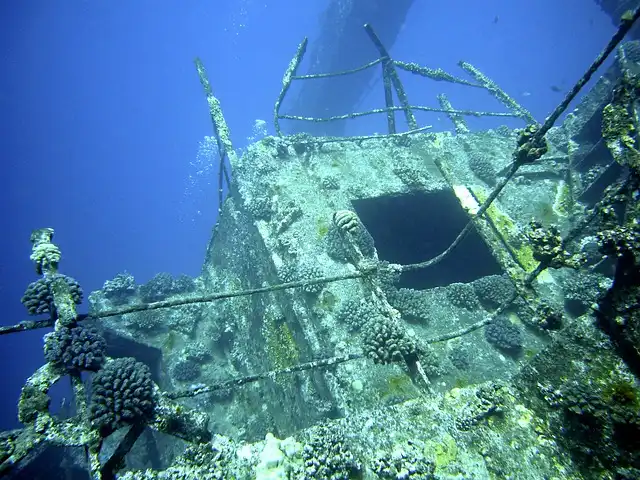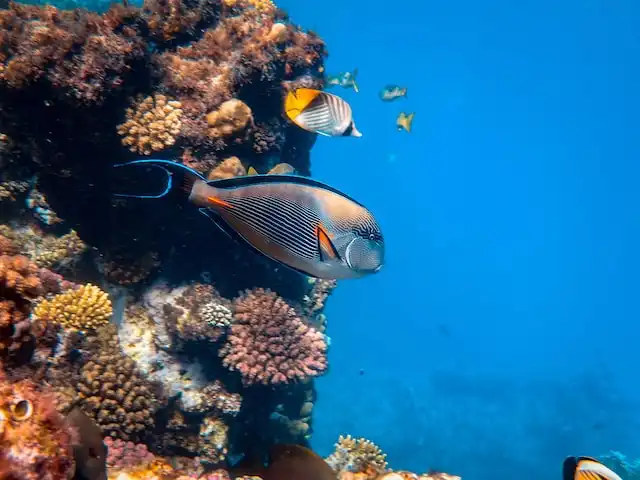Banana Reef Dive Site
Explore the legendary banana-shaped reef in North Male Atoll - one of the Maldives' first discovered and most iconic dive sites featuring dramatic overhangs, caves, and vibrant marine life
About Banana Reef
Banana Reef is one of the most famous and historically significant dive sites in the Maldives. Located in North Male Atoll (Kaafu Atoll), this iconic site was among the first to be discovered for diving in the Maldives in the early 1970s and remains a must-visit destination for divers from around the world.
Named for its distinctive curved banana shape, this reef offers an incredible diversity of underwater features including dramatic overhangs, caves, steep drop-offs, and vibrant coral formations. The reef's unique topography creates varied diving conditions that support an extraordinary range of marine life.
Banana Reef is suitable for divers of all experience levels, though currents can be strong at times. Its proximity to Male makes it easily accessible for day trips, and many nearby resorts include it in their regular diving itineraries.
Banana Reef Quick Facts
- Location: North Male Atoll (Kaafu Atoll)
- Depth Range: 5-30 meters (16-100 feet)
- Visibility: 15-30 meters (50-100 feet)
- Current: Moderate to strong
- Experience Level: Beginner to Advanced
- Best Time to Dive: Year-round (best Dec-Apr)
- Marine Protected Area: Yes
- Distance from Male: Approximately 8 km
Underwater Features
Banana Reef offers a remarkable variety of underwater landscapes and features that make it one of the most diverse dive sites in the Maldives.

Dramatic Overhangs
The reef's eastern side features impressive overhangs that create dramatic shadows and shelter numerous marine species. These structures are covered with colorful soft corals and sponges.

Caves and Swim-Throughs
Several small caves and swim-through passages provide exciting exploration opportunities. These features are home to moray eels, lobsters, and various crustaceans.

Steep Drop-offs
The outer edge of the reef features dramatic drop-offs that plunge into the deep blue. These walls are excellent spots for observing pelagic species and larger predators.

Vibrant Coral Gardens
Extensive coral gardens cover large portions of the reef, featuring both hard and soft coral species in a kaleidoscope of colors, providing habitat for countless reef fish.
Marine Life at Banana Reef
Banana Reef is renowned for its incredible biodiversity, hosting a wide variety of marine species from tiny reef dwellers to impressive pelagics.

Napoleon Wrasse
These impressive fish with distinctive bump-shaped heads are regular residents at Banana Reef. They can grow up to 2 meters in length and are known for their curious nature.

Grey Reef Sharks
Often spotted patrolling the outer edges of the reef, these elegant sharks are a highlight for many divers. They're typically seen in small groups, especially in areas with stronger currents.

Groupers
Several species of groupers inhabit the reef's caves and overhangs, including the giant grouper and honeycomb grouper. These territorial fish are fascinating to observe.

Parrotfish
Vibrantly colored parrotfish are abundant on the reef, playing a crucial role in maintaining reef health by consuming algae and creating sand through their feeding habits.

Sea Turtles
Hawksbill and green sea turtles are frequently encountered at Banana Reef, often seen feeding on sponges or resting in coral formations.

Eagle Rays
Spotted eagle rays are regular visitors to the reef, often seen gliding gracefully along the reef's edge or in the blue water beyond the drop-offs.
Banana Reef Dive Map
Banana Reef is located in North Male Atoll, approximately 8 kilometers from Male. The reef's distinctive banana shape stretches for about 300 meters, with various dive entry points depending on current conditions.
Key Dive Zones:
- Northern Tip: Features dramatic overhangs and strong currents, best for experienced divers
- Eastern Wall: Steep drop-offs with caves and swim-throughs
- Central Section: Extensive coral gardens ideal for photographers
- Southern End: Gentler slope with abundant reef fish, suitable for beginners
Most dive operators will choose the entry point based on current conditions, typically starting at the upcurrent end and drifting with the current along the reef.
Diving Tips for Banana Reef
Current Management
Currents at Banana Reef can be strong and unpredictable. Always dive with an experienced guide who knows the site well. Use reef hooks when appropriate and stay close to the reef in stronger currents.
Best Time to Dive
Early morning dives (7-9 AM) typically offer the best visibility and marine life activity. The northeast monsoon season (December-April) generally provides calmer conditions and better visibility.
Photography Tips
Bring a wide-angle lens for the dramatic overhangs and reef scenes, plus a macro option for the abundant small marine life. The eastern wall's soft corals make for spectacular photos in morning light.
Marine Life Encounters
For the best chance of shark encounters, visit during incoming tides. Napoleon wrasse are often spotted near the northern section, while turtles frequently visit the central coral gardens.
Nearby Dive Sites
North Male Atoll offers several other world-class dive sites within easy reach of Banana Reef. Consider these options for a multi-dive itinerary in the area.




Practical Information
How to Get There
Banana Reef is easily accessible from Male and nearby resorts in North Male Atoll. Most dive centers and resorts in the area offer regular trips to this iconic site.
Access Options:
- Resort Dive Centers: If staying at a North Male Atoll resort, their dive center will likely offer daily trips to Banana Reef
- Day Trips from Male: Several dive operators in Male offer day trips to Banana Reef
- Liveaboard Vessels: Most liveaboard diving cruises in the Maldives include Banana Reef in their North Male Atoll itineraries
Best Resorts for Diving Banana Reef
Dive Conditions
- Depth Range: 5-30 meters (16-100 feet)
- Visibility: 15-30 meters (50-100 feet)
- Currents: Moderate to strong, variable
- Water Temperature: 27-30°C (81-86°F)
- Experience Level: Beginner to Advanced
Certification Requirements:
- Open Water Diver or equivalent
- Advanced certification recommended during strong currents
- Minimum 10-20 logged dives recommended
Conservation Notes:
- Banana Reef is a protected marine area
- No touching or collecting marine life
- Maintain proper buoyancy to protect corals
- Follow responsible diving practices
Banana Reef Photo Gallery






Diver Reviews
A Must-Dive Site in the Maldives
"Banana Reef was the highlight of my diving trip to the Maldives. The variety of underwater landscapes is incredible - from dramatic overhangs to vibrant coral gardens. We saw napoleon wrasse, reef sharks, and even an eagle ray. Currents were moderate but manageable. Highly recommended for any diver visiting North Male Atoll!"
- Sarah T., Advanced Diver from Australia
Incredible Marine Life
"The biodiversity at Banana Reef is outstanding. During our dive, we encountered schools of snappers, groupers, and even a couple of reef sharks. The coral health is impressive compared to many other sites I've visited worldwide."
- Michael K., Divemaster from Germany
Beautiful but Watch the Currents
"Banana Reef is stunning but be prepared for potentially strong currents. We caught it on a day with significant water movement, which made photography challenging. Still, the overhangs and caves were spectacular and worth the effort."
- Akiko M., Underwater Photographer from Japan
Frequently Asked Questions
Banana Reef can be suitable for beginners during calm conditions, particularly at the southern end of the reef where currents are typically milder. However, when currents are stronger, it's better suited for intermediate to advanced divers. Always dive with an experienced guide who can assess conditions and choose the appropriate entry point based on your experience level.
Banana Reef can be dived year-round, but the northeast monsoon season (December to April) generally offers the best conditions with calmer seas and better visibility. Early morning dives typically provide the best visibility and marine life activity. Tidal conditions also affect the dive experience, with incoming tides often bringing clearer water and more pelagic species.
Banana Reef hosts an incredible diversity of marine life including napoleon wrasse, grey reef sharks, eagle rays, hawksbill turtles, and various grouper species. The reef is also home to abundant tropical fish including snappers, fusiliers, butterflyfish, and angelfish. The overhangs and caves shelter moray eels, lobsters, and various crustaceans, while the coral gardens support a vibrant ecosystem of smaller reef dwellers.
Banana Reef is accessible via dive boats from Male and nearby resorts in North Male Atoll. Most resorts in the area offer regular dive trips to Banana Reef through their on-site dive centers. If staying in Male, several dive operators offer day trips to the reef. Liveaboard diving cruises that visit North Male Atoll typically include Banana Reef in their itineraries.
In addition to standard diving equipment, consider bringing a reef hook for use during stronger currents (only use on dead coral or rock under guide supervision). A dive computer is essential for monitoring depth and bottom time. For photographers, both wide-angle and macro capabilities are useful. A surface marker buoy (SMB) is recommended for safety. Exposure protection is minimal - a 3mm wetsuit or rashguard is typically sufficient in the warm Maldivian waters.
Experience Banana Reef
Discover this legendary dive site with expert guides and unforgettable marine encounters. Book your diving adventure in North Male Atoll today.
Explore Diving Packages